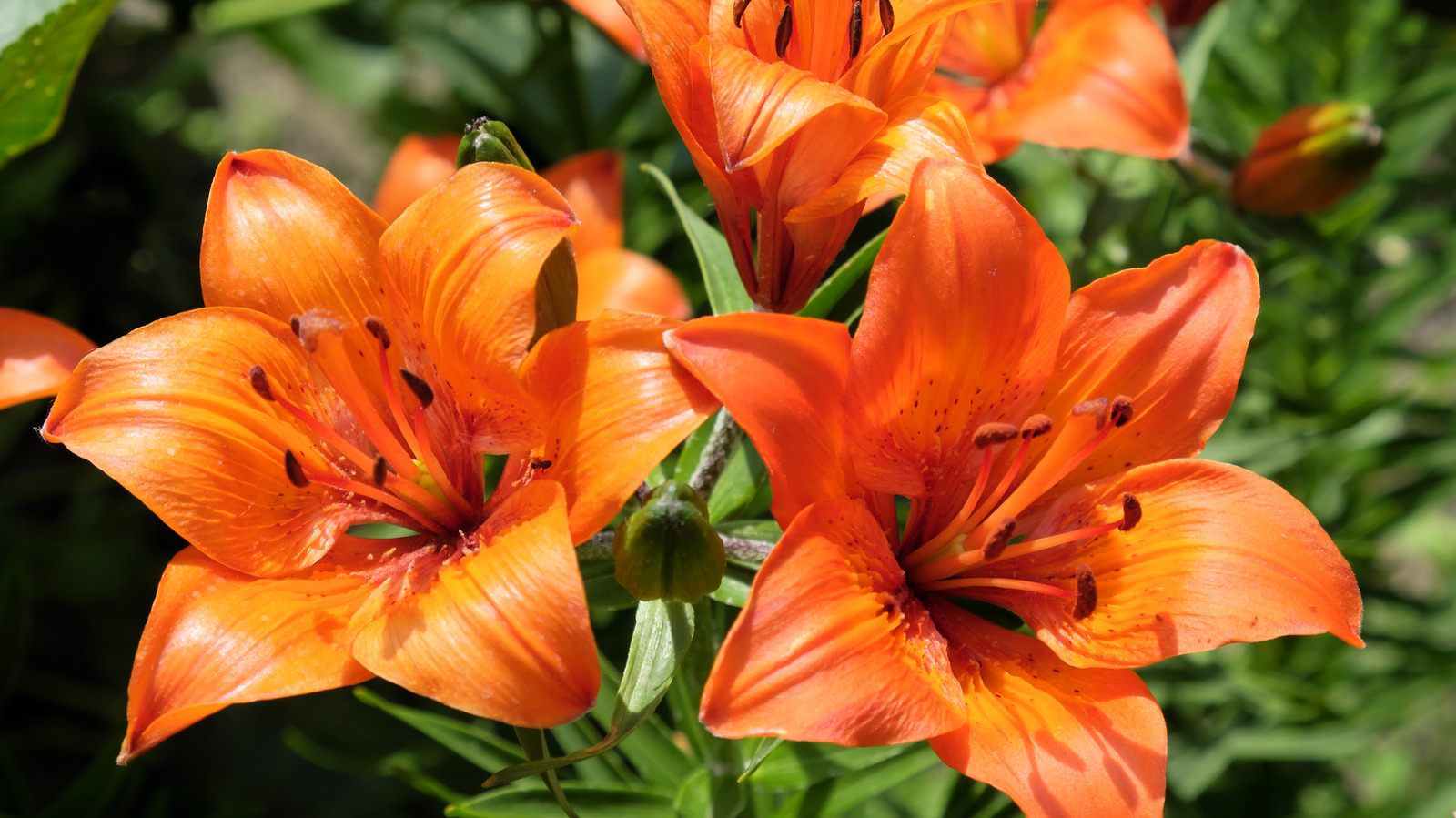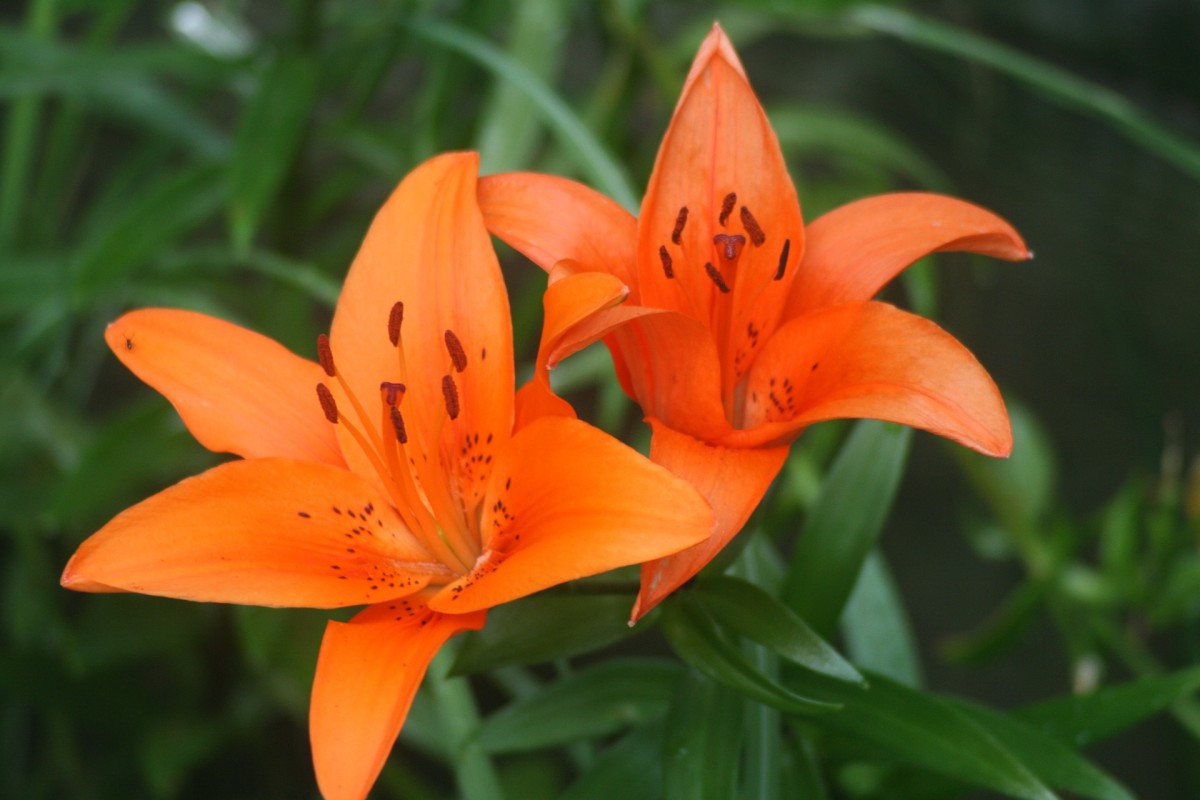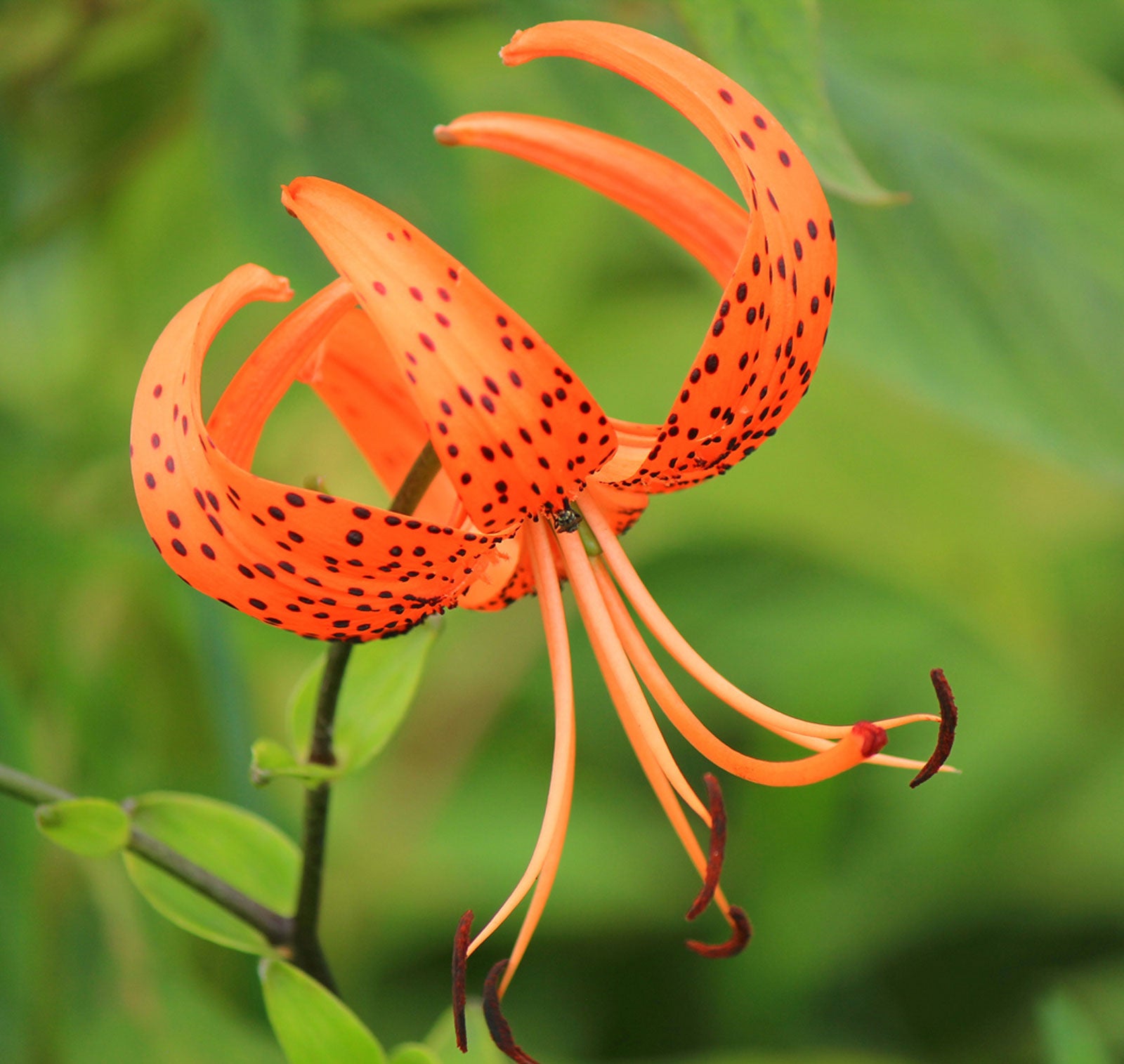Can a flash of orange and black transform your garden into a summer spectacle? Absolutely! Tiger lilies, with their vibrant blooms and intriguing history, offer a rewarding experience for any gardener, promising a dazzling display with the right care and attention.
The allure of the tiger lily, Lilium lancifolium or Lilium tigrinum, extends far beyond its striking appearance. Native to the eastern regions of Asia, including China, Japan, Korea, and the Russian Far East, this herbaceous perennial has captivated gardeners for centuries. Its common name stems from the distinctive black spots that adorn its orange petals, resembling the stripes of a tiger. These summer flowers, blooming in mid to late summer, are not merely pretty; they are resilient, hardy, and surprisingly easy to cultivate, making them a favorite among both novice and experienced gardeners. They are perennial bulbs, ready to grace your garden year after year, offering a burst of color when many other flowers have faded.
Here's a breakdown of the tiger lily, focusing on both the plant itself and the character from the Peter Pan story:
- Unveiling The Wealth Of Devante Swing From Jodeci Net Worth Biography And Legacy
- Exploring Dr Doug Weiss Net Worth Insights Into His Life Career And Success
| Feature | Details |
|---|---|
| Botanical Name | Lilium lancifolium (synonym: Lilium tigrinum) |
| Common Names | Tiger Lily, Tiger Lily |
| Origin | Eastern Asia (China, Japan, Korea, Russian Far East) |
| Type | Herbaceous Perennial Bulb |
| Height | 1 to 1.5 meters (3 to 5 feet) |
| Width | 30 to 60 centimeters (12 to 24 inches) |
| Bloom Time | Mid to Late Summer |
| Flower Color | Orange with Black Spots (various colors exist) |
| Soil Preference | Loose, well-draining, slightly acidic (pH 5.5-6.5) |
| Light Requirements | Full Sun to Partial Shade |
| Propagation | Bulbils, Division, Seeds |
| Hardiness Zones | Typically zones 3-9, depending on the variety |
| Toxicity | Toxic to cats; mildly toxic to humans if ingested in large quantities |
| Symbolism | Wealth, prosperity, pride |
Cultivating the Tiger Lily: A Gardener's Guide
Growing tiger lilies is a relatively straightforward process, even for beginners. The key to success lies in understanding their basic needs and providing the right conditions. Firstly, selecting the right location is crucial. Tiger lilies thrive in full sun to partial shade, with at least six hours of sunlight daily being ideal. Ensure the chosen spot has well-draining soil, as tiger lilies do not tolerate waterlogged conditions. These bulbs prefer loose, slightly acidic soil with a pH between 5.5 and 6.5. If your soil is heavy or compacted, amend it with compost, well-rotted manure, or other organic matter to improve drainage and fertility. Additionally, they prefer soil that is loose and not compacted. The best time to plant tiger lily bulbs is in the fall or early spring. Plant the bulbs 6 inches (15 centimeters) deep and space them 9 to 12 inches (23 to 30 centimeters) apart.
Planting and Care
- Steven Williams Net Worth An Indepth Look At His Wealth And Achievements
- Judge Jeanines Net Worth A Deep Dive Into Her Wealth And Achievements
Prepare the soil by loosening it to a depth of at least 12 inches (30 centimeters). Incorporate organic matter, such as compost or well-rotted manure, to improve drainage and add nutrients. Plant the bulbs with the pointed end facing upwards. After planting, water the bulbs thoroughly. During the growing season, water regularly, especially during dry spells. Avoid overwatering, which can lead to rot. Fertilize in early spring with a balanced fertilizer formulated for flowering plants. Follow the package instructions for application rates. Deadhead spent flowers to encourage further blooming and prevent seed production. In the fall, cut the stems back to the ground after the foliage has died back. Mulch the plants with a layer of organic matter to protect the bulbs during the winter.
Watering and Fertilizing
Watering tiger lilies should be done with care. These plants prefer consistently moist soil but are susceptible to rot in overly wet conditions. Water deeply but infrequently, allowing the top inch of soil to dry out between waterings. Fertilization is also an important aspect of tiger lily care. A balanced fertilizer, applied in early spring as the shoots emerge, will provide the necessary nutrients for healthy growth and abundant blooms. Choose a fertilizer formulated for flowering plants and follow the manufacturer's instructions for application.
Propagation
Tiger lilies are also relatively easy to propagate. One of the easiest methods is through the use of bulbils. These small, black bulb-like structures form in the leaf axils (where the leaves meet the stem) of the plant. Once the bulbils mature and drop from the plant, they can be collected and planted directly into the soil. Dig a hole about 8 inches deep to begin the propagating process. The bulbils will develop roots and produce new plants. Propagation by division is also possible. After the foliage has died back in the fall, carefully dig up the clumps of bulbs and divide them. Replant the individual bulbs in separate locations. For those who enjoy a challenge, tiger lilies can also be propagated from seeds, although this method takes longer and may not produce plants that are identical to the parent plant.
Common Problems and Solutions
Like all plants, tiger lilies can be susceptible to certain problems. One common issue is fungal diseases, such as botrytis blight, which can occur in overly wet conditions. Good air circulation and proper watering practices can help prevent these diseases. Pests such as aphids and lily leaf beetles can also affect tiger lilies. Inspect your plants regularly and take action at the first sign of infestation. Organic insecticides or manual removal of pests can be effective control methods. Basic tiger lily needs and common problems have ties with each other. Proper care helps maintain plant health and minimize issues.
Beyond the Garden: Tiger Lilies in Culture and Symbolism
The tiger lily holds a rich history and symbolism, making it more than just a beautiful garden plant. The exact meanings of these flowers can depend on the culture or area of the world. In general, the tiger lily is associated with wealth, prosperity, and pride. In some cultures, it also symbolizes femininity and strength. The vibrant orange color of the blooms further enhances the flower's appeal, representing warmth, energy, and enthusiasm. With their exotic beauty and resilience, tiger lilies have also become a favorite in floral arrangements and bouquets, adding a touch of elegance and sophistication to any occasion. Consider the color meanings and symbolism when including tiger lilies in your floral arrangements.
Tiger Lily in Peter Pan
Beyond the garden, the name "Tiger Lily" is familiar to many because of the character from Disney's 1953 animated feature film Peter Pan. She is a supporting character in the movie, and the beautiful daughter of Neverland's indigenous Indian chief and a loyal friend of Peter Pan. She resides in the Indian camp on Neverland and serves as the princess of her people, ruling the tribe. In this context, the name "Tiger Lily" represents a strong and independent woman, reflecting the flower's own inherent hardiness and beauty.
Tiger Lily and other lilies
Tiger lilies, also known as Lilium lancifolium, are a type of true lily, belonging to the genus Lilium. This means they share characteristics with other popular lilies, such as trumpet lilies, Asiatic lilies, and Oriental lilies. However, tiger lilies stand out due to their unique appearance and specific care requirements. When comparing tiger lilies to other lilies, its important to consider factors like bloom time, flower shape, color, and preferred growing conditions. For example, Asiatic lilies are generally easier to grow and bloom earlier in the season, while Oriental lilies are known for their fragrant, late-season blooms. Understanding the differences between the various lily types will help gardeners choose the best varieties for their specific needs and preferences.
Tiger Lily and Different Climates
Tiger lilies are adaptable plants that can thrive in a range of climates, but they do have specific preferences. These lilies are generally hardy in USDA zones 3-9, which means they can tolerate a wide range of temperatures, from very cold winters to hot summers. However, the success of growing tiger lilies also depends on microclimate factors. They thrive in areas with full sun to partial shade, as well as well-drained soil. Gardeners in hotter climates may need to provide some shade during the hottest parts of the day to prevent the plants from scorching, while those in colder regions should consider mulching their plants to protect the bulbs during the winter months.
Tiger Lily and Different Soils
The soil is essential to a tiger lily's health. They prefer slightly acidic soil with a pH between 5.5 and 6.5. They also prefer soil that is loose and not compacted. Well-draining soil is crucial to prevent the bulbs from rotting. Before planting, its a good idea to test the soil pH and make any necessary adjustments, such as adding lime to raise the pH or sulfur to lower it. Moreover, amending the soil with organic matter like compost or well-rotted manure will improve drainage, fertility, and overall soil health. Because tiger lilies are herbaceous perennials, they return year after year, they benefit greatly from quality soil.
Tiger Lily and Growing Habits
The growing habits of tiger lilies are quite distinct. These plants typically grow to about 1 to 1.5 meters tall and can reach a width of 30 to 60 centimeters. Young plants start out with just one stem, but older plants can have several stems, creating a fuller appearance. Tiger lilies are known for their vigorous growth and ability to spread through bulbils. These bulbils form along the stem where the leaves attach, eventually dropping off and developing into new plants. This means a single plant can rapidly colonize an area, leading to an impressive display of blooms. The growing habits make them a great addition to any garden.
Tiger Lily and Benefits
Growing tiger lilies offers numerous benefits to the gardener and the garden itself. The most obvious benefit is their stunning beauty, with their vibrant orange blooms adding a touch of elegance and color to any garden. They are also relatively low-maintenance plants that are easy to care for once established. Tiger lilies are perennials, so they will return year after year, providing a reliable source of beauty with minimal effort. They attract pollinators like bees and butterflies, which is good for the overall ecosystem. Furthermore, tiger lilies can be used in cut flower arrangements, bringing their beauty indoors. Also, they are hardy and adaptable to different climates, making them a versatile option for gardeners in many regions. These factors provide many benefits to both the gardener and the surrounding environment.



Detail Author:
- Name : Gustave Satterfield
- Username : zlehner
- Email : erika.prosacco@gmail.com
- Birthdate : 1979-06-10
- Address : 9941 Dickinson Mill Karinaburgh, LA 72367-8916
- Phone : 520.793.1434
- Company : Brown-Kshlerin
- Job : Welding Machine Setter
- Bio : Eveniet tempora voluptatem maiores odio nulla quas. Nesciunt dolorum aut eius. Quos consequatur neque voluptas tenetur dolore est.
Socials
tiktok:
- url : https://tiktok.com/@annabellkshlerin
- username : annabellkshlerin
- bio : Nisi totam qui impedit ea reiciendis cumque dolor exercitationem.
- followers : 3191
- following : 2028
instagram:
- url : https://instagram.com/kshlerina
- username : kshlerina
- bio : Aspernatur voluptatem amet unde mollitia velit. Quasi ipsa inventore ratione occaecati aut.
- followers : 598
- following : 148
linkedin:
- url : https://linkedin.com/in/kshlerin1980
- username : kshlerin1980
- bio : Asperiores vel quod recusandae.
- followers : 6087
- following : 2620
twitter:
- url : https://twitter.com/kshlerin2019
- username : kshlerin2019
- bio : Et deserunt occaecati iste ex mollitia sint nostrum dolore. Sed laudantium nihil ut dolorem eius quia ducimus eos. Et praesentium commodi velit quaerat.
- followers : 3059
- following : 759